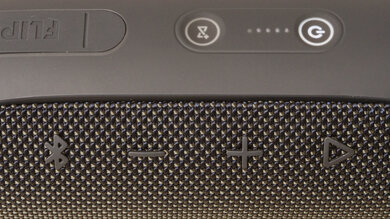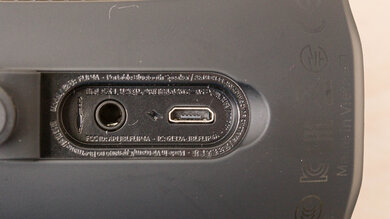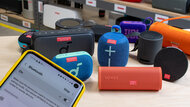The JBL Flip 4 is a portable Bluetooth speaker that comes in lots of different color variants to meet your unique style. It's a small and lightweight device that's designed to bring your favorite tunes with you on the go, and its detachable carrying strap makes it easy to attach to your bag while you're out and about. It's even rated IPX7 for water resistance, meaning you can immerse it in up to a meter of water for 30 minutes.
Our Verdict
The JBL Flip 4 isn't bad for music. Right out of the box, you get a fairly even sound, especially in the mids. Voices and lead instruments are clear and detailed in the mix, making it suitable for listening to a wide array of audio content. That said, since it's a smaller speaker, it can't bring the deep thump and rumble in the low-bass that's often found in genres like EDM and hip-hop. Plus, there aren't any customization tools to switch up its sound.
-
Pairs with up to two devices at once.
-
Clear vocal reproduction.
-
No customization tools.
-
Not a lot of low-bass.
The JBL Flip 4 is passable for videos and movies. It isn't designed with this use in mind, but if you want to watch a video on a paired smartphone, it can get the job done. Dialogue is clearly reproduced, and the low latency ensures that you don't have any issues with lip-synching. However, compared to speakers that are designed for movies, it doesn't get as loud and doesn't bring as much rumble in the bass.
-
Pairs with up to two devices at once.
-
Clear vocal reproduction.
-
Not a lot of low-bass.
-
Doesn't get as loud as other speakers.
The JBL Flip 4 is decent for podcasts. Dialogue is reproduced with great clarity right out of the box, meaning you can follow along with your favorite hosts with ease. Its portable design means you can bring it with you from room to room. It's better for listening in more average-sized rooms since it doesn't get loud enough to fill larger, more open spaces with sound.
-
Pairs with up to two devices at once.
-
Portable design.
-
No customization tools.
-
Doesn't get as loud as other speakers.
The JBL Flip 4 is disappointing for voice assistants. It doesn't have any built-in support for voice assistants, so you have to use the tools integrated into your smartphone when paired with the device. As a result, you can't activate it with only your voice. Still, once you set it up, the speaker does a decent job picking up your commands, especially in noisier environments like parties.
-
Portable design.
-
No built-in voice assistant support.
-
No mic mute button.
The JBL Flip 4 is decent for outdoor use. It's a lightweight and small Bluetooth speaker that's easy to carry with you wherever you go. There's even a removable carrying strap in case you want to clip it onto your bag. Plus, it's rated IPX7 for water resistance, meaning it can withstand some light exposure to the elements. It doesn't get quite as loud as some other speakers on the market, so it's better for a small picnic with friends than a booming backyard party.
-
IPX7 Rating for water resistance.
-
Portable design.
-
No customization tools.
-
Doesn't get as loud as other speakers.
- 6.3 Music
- 6.0 Videos/Movies
- 7.3 Podcasts
- 5.3 Voice Assistant
- 7.0 Outdoors
Changelog
- Updated Jan 04, 2023: Updated review text for clarity and consistency. No changes in test results.
- Updated Nov 08, 2021: Review published.
- Updated Nov 04, 2021: Early access published.
- Updated Oct 22, 2021: Our testers have started testing this product.
- Updated Oct 20, 2021: The product has arrived in our lab, and our testers will start evaluating it soon.
Check Price
Differences Between Sizes And Variants
The JBL Flip 4 waterproof portable Bluetooth speaker comes in eight color variants: Black, Blue, Camouflage, Gray, Ocean Blue, Red, Teal, and White. We expect them to perform similarly. We tested the 'Black' variant, and you can find its label here.
If you come across other variants, let us know in the discussions, and we'll update our review.
Compared To Other Speakers
The JBL Flip 4 is a small portable Bluetooth speaker with a removable carrying strap to help transport it. Unlike the JBL Flip 5, this small speaker has a microphone, meaning you can use voice assistants through your smartphone. It has an overall balanced sound profile out of the box, though it struggles to produce a thumpy low-bass. It also comes with a JBL Connect+ feature you can use to connect it to multiple other JBL Connect+ speakers, like the JBL Charge 4. However, you can't connect it to PartyBoost-compatible JBL speakers like the JBL Flip 5 or the JBL Charge 5. Like most JBL speakers we've tested, it also lacks sound customization features like a graphic EQ to adjust its sound to your liking.
See also our recommendations for the best Bluetooth speakers, the best JBL speakers, and the best cheap speakers.
The JBL Flip 4 is more versatile than the JBL Flip 6. When placed horizontally, the Flip 4 can play stereo content without downmixing it to mono, which is more immersive. It has a longer-lasting battery life and features an AUX input to wire your devices to the speaker. Also, it supports voice assistants through your smartphone. However, the Flip 6 has a graphic EQ to customize its sound profile to your liking. It's better built with an IP67 rating for dust and water resistance, certifying it to be dust-tight and immersible in up to a meter of water for 30 minutes. It also has better directivity, resulting in a wider-sounding soundstage. That said, the Flip 4 can only pair with JBL speakers that support JBL Connect+, while the Flip 6 can only pair with PartyBoost-compatible speakers.
The JBL Flip 4 is a more versatile speaker than the JBL Flip 5 overall, though they're very similar and have different strengths. The Flip 4 can play stereo content without downmixing it to mono and supports voice assistants through your smartphone, thanks to a built-in microphone. You can also only connect it to JBL speakers that are compatible with JBL Connect+. That said, the Flip 5 can produce a more extended low-bass than the Flip 4 and can only connect to PartyBoost-compatible JBL speakers.
The JBL Flip 4 is a better speaker than the JBL Charge 4. The Flip 4 has a better-balanced sound profile out-of-the-box and can play stereo content without downmixing it to mono, which is more immersive. It supports voice assistants through your smartphone and is smaller, making it more portable. However, the Charge 4 can produce a more extended low-bass than the Flip 4. It also has a longer-lasting battery life, though this can vary depending on your usage, and your experience may differ.
The JBL Charge 5 and JBL Flip 4 are similar speakers with different strengths. The Flip 4 is smaller, making it easier to carry around when you're on the go. It can play stereo content without downmixing it to mono, resulting in a more immersive soundstage. It also supports voice assistants through your smartphone. The JBL Charge 5 offers a better-balanced sound profile and a longer-lasting 14.5-hour battery life. However, battery performance can vary depending on your usage, and your experience may differ. Also, while the Flip 4 is compatible with JBL speakers that support JBL Connect+, the Charge 5 can only be paired with PartyBoost-compatible JBL speakers.
The JBL Flip 4 is a better speaker than the Bose SoundLink Micro overall. The Flip 4 has a better-balanced sound profile out-of-the-box, can play stereo content without downmixing it to mono, and can get louder. That said, the Bose is a bit smaller, making it more portable. It has a bit less compression present at max volume, resulting in cleaner-sounding audio at louder volumes.
The JBL Flip 4 is a better speaker than the JBL Go 3. The Flip 4 has a better-balanced sound profile out-of-the-box that can produce a more extended low-bass than that of the Go 3. It can play stereo content without downmixing it to mono and supports voice assistants via your smartphone. That said, the Go 3 is smaller, making it more portable. It's also better built with an IP67 rating for dust and water resistance, so it's fully dust-tight and submersible in up to a meter of water for 30 minutes.
The Anker Soundcore Motion+ is a better speaker than the JBL Flip 4 overall. With its BassUp feature enabled, the Anker can produce a more extended low-bass and can get louder than the JBL. You can also customize its sound to your liking using the graphic EQ and presets in its companion app. That said, the JBL has a more neutral sound profile out-of-the-box. You can also connect it to multiple other JBL speakers that support JBL Connect+.
Depending on your listening habits, you may prefer either the JBL Flip 4 or the Sony SRS-XB23. The JBL offers a better-balanced sound profile out-of-the-box and can get a bit louder with less compression present at max volume, so audio sounds cleaner at louder volumes. That said, the Sony offers a wider-sounding soundstage, and you can customize its sound profile to your liking via the graphic EQ featured in its companion app. It's also better-built with an IP67 rating for dust and water resistance, certifying it to be dust-tight and immersible in a meter of water for up to 30 minutes.
Depending on your listening habits, you may prefer either the JBL Flip 4, or the Sony SRS-XB13. The JBL can get louder and can produce a more extended low-bass. It can play stereo content without downmixing it to mono, resulting in a more immersive soundstage. You can connect it to other JBL Connect+ speakers to create a stereo pair or amplify your audio across a large area. However, the Sony is smaller, making it more portable. It's better-built with an IP67 rating for dust and water resistance, certifying it to be fully dust-tight and immersible in up to a meter of water for 30 minutes. It also has better directivity, so its soundstage is perceived as wider and more open-sounding.
You may prefer either the TREBLAB HD77 or the JBL Flip 4, depending on your listening habits. The TREBLAB offers a wider and more open-sounding soundstage. Its battery also lasted around two hours longer in our tests, though this varies depending on your usage. However, the JBL has a better-balanced sound profile out-of-the-box and has less compression present at max volume, resulting in cleaner audio at louder volumes. It supports voice assistants through your smartphone and can pair to multiple other JBL Connect+ speakers.
Test Results
This cylindrical speaker has a very similar design to the JBL Flip 5. You can place it horizontally and vertically. It also comes with a removable carrying strap and can be purchased in many different colors and styles.
The JBL Flip 4 has good build quality. It feels solid overall and is wrapped in a tight fabric that doesn't seem like it can rip easily. Its controls are rubber, and there's a rubber strip that extends along the speaker, covering its power and JBL Connect+ buttons. It's rated IPX7 for water resistance, so it's certified for immersion in up to a meter of water for up to 30 minutes, but only when the rubber flap protecting its inputs is tightly sealed.
The controls are easy to press. You can use the play button to play/pause your audio and double-press it to skip to your next track, though there isn't a way to backtrack. You can even program it to activate the voice assistants on your phone via its JBL Portable companion app. However, doing so will no longer let you use the play button for other functions. There's a JBL Connect+ button that you can use to connect the Flip 4 to multiple other JBL Connect+ speakers. Unfortunately, this means you can't connect the Flip 4 to PartyBoost-compatible speakers like the JBL Flip 5.
There's a chime to inform you when you've reached its max volume level. The power and Bluetooth buttons also have light indicators to inform you of their status, as well as the speaker's battery level.
The JBL Flip 4 has a passable frequency response accuracy. While placed horizontally, it has a fairly balanced sound profile out of the box, making it suitable for listening to a wide variety of audio content. Its balanced mid-range ensures vocals and lead instruments sound clear and present in the mix. Unfortunately, like most speakers its size, it struggles to reproduce low-bass, so you can't feel the deep thump and rumble in bass-heavy music. It doesn't reproduce as much bass as the JBL Flip 5, either.
This speaker plays stereo content when placed horizontally. That said, if you place the speaker vertically, the tweeters separating the right and left channels don't switch to mono, and you can't hear the channel separation as clearly. Its directivity is just okay, so its soundstage is perceived as somewhat narrow and directional. For a similar speaker with a fantastic soundstage performance, check out the TREBLAB HD77.
This speaker gets loud enough to fill an average-sized living room with sound. However, it struggles in larger and more open spaces. Also, as you crank up the volume, there's more compression in the mix.
While it's advertised to last up to 12 hours off a single charge, this speaker lasts a little over nine hours. That said, battery life can vary depending on your usage habits, so your real-world experience may differ. While there isn't an advertised power-saving feature, the speaker turns off automatically when left inactive for around an hour.
This speaker doesn't have voice assistants built in, but you can still access Google Assistant and Siri when connected to your smartphone. The mic does a decent job of picking up your commands from far away and does a great job in noisier settings. Unfortunately, there isn't a mute microphone button for when you no longer want it to hear you.
Note: You can set the play button to trigger your voice assistant in the JBL Portable app. However, you can no longer use the play button to play and pause your audio once it's been set up to trigger voice assistants.
The JBL Portable app is alright. It's compatible with both iOS and Android devices. You can use it to program the play button to activate the voice assistants from your phone. However, setting this up will no longer allow you to use the play button to play and pause your audio. You can also use the JBL Connect+ feature to connect other JBL Connect+ speakers when you want to create a stereo pair or when you want your audio to fill a large space without increasing the volume. You can't pair the Flip 4 to JBL speakers that are PartyBoost-compatible, like the JBL Flip 5 or the JBL Charge 5. Unfortunately, there aren't any sound customization features like presets or a graphic EQ to customize the speaker's sound.
Aside from its charging port, this speaker also comes with an AUX input that you can use to wire your devices to the speaker.
You can pair this speaker to up to two devices at once, which is handy when you need to quickly switch between audio sources. It also has low latency with iOS and Android devices, making it suitable for watching videos and movies over this connection. Some apps compensate for latency differently, so your experience may vary.
Comments
JBL Flip 4: Main Discussion
Let us know why you want us to review the product here, or encourage others to vote for this product.


































